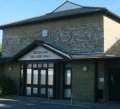Early days in Bosham
A small attractive village on one of the
small inlets of Chichester harbour Bosham (pronounced 'Bozzum') has
played its part in our countries history. Before the Norman Invasion
Bosham was an important part of the Saxon world, it is one of only five
places that appear on the map attached to the 12th century "Saxon
Chronicle".
Vespasian, commander of 2nd Legion in Britain (Later to become Emperor)
landed here in 42AD he later built a villa in the area. It was also used
by the Romans as a port.
Before St Wilfred brought Christianity to Sussex, St Bede wrote of a
Celtic monk called Dicul who had a small monastic order at Bosham. Dicul
established a church in the 7th Century on the remains of the Roman
Basilica dedicated to Mithras. By 750 AD the village was being called
Bosanhamm, meaning the watermeadow of Bosa.
King Canute had a palace at Bosham. It was here at Bosham that King
Canute ordered the tide not to come in. He was continually being told
how all powerful he was and he decided that his courtiers needed a
practical lesson in his mortality and to demonstrate that he was just a
King and nothing more he placed his throne at the edge of the sea and
commanded that the waves should stop, obviously they didn't. King
Canutes young daughter was buried in the church in 1020, she drowned
when she slipped and fell into the millstream. Canute himself died in
1035, Harold I Canute's illegitimate son was then elevated to King by
popular demand. His reign was a short one, he came to the throne on 1037
and died in 1040. With the support of Earle Godwine Edward the Confessor
became king in 1042. In 1066 Edward became ill and died, Earle Godwine
then placed his son Harold II on the throne.
Earle Godwine of Wessex father of King Harold II lived in or near
Bosham, as did Harold II himself. Earle Godwine was the real power in
the country and he ruthlessly murdered anyone who had claim to the
throne. As shown on the Bayeux Tapestry, Harold went to mass at Bosham
in 1064 prior to meeting William of Normandy, it was at this meeting
that Harold told William he would be claiming the throne of England for
himself. Harold was destined to be the last Saxon King of England. Some
say Earle Godwine's body was brought back to Bosham after the Battle of
Hastings and claim he was buried beneath the chancel arch.
In 1664 the Great Plague was sweeping through the country, when the
plague reached nearby Chichester the citizens shut the City gates and
sealed themselves in, in an attempt to stop the plague from spreading to
people outside the City. The fishermen of Bosham took it upon themselves
to help as best they could and left food outside the city gates, this
continued until the plague had passed. In recognition of this, the
fishermen were allowed to sell their fish in the market without having
to pay a fee.
On the 4th August 1865 the chancel arch was excavated, two coffins were
discovered. One contained the bones of an eight year old girl; the
coffin itself was typical of coffins used during the reign of Canute.
The larger coffin contained the bones of a 60 year old man who suffered
from arthritis in one leg. It is known that Earle Godwine had a limp.
Bosham (Bozz'm) has invariably had a good press. A random trawl through
half a dozen travel books produces the same sort of language: "One of
the most charming places in Sussex... Outstandingly pretty ... a gem of
a place." And so on.
Only E.V Lucas, writing at a start of the century and ever on the
out-look for a phrase to stop the reader in his tracks, called Bosham "a
slut", showing a vast tracks of mud at low tide. On the other hand, he
said, at high water she was " a fair abode of peace."
Bosham stands on a little peninsula between two tidal creeks at the
eastern end of Chichester's inland harbour. As well as providing a
sanctuary for migrating wildfowl - shelduck, wigeon, Brent geese, waders
and many more - it is a wonderful centre for sailing. Artists, walkers
and weekenders love the place, and at this time of the year it draws
visitors like a magnet.
Particularly those with a sense of history. Where else would you find in
a local parish church the original chancel that is depicted and named in
the Bayeux Tapestry? With Harold entering it to pray before crossing the
Channel from these very waters more than 900 years ago to parley about
the English throne with William of Normandy.
An earlier king, Canute - he of the "turn back the tide" story - also
knew Bosham. The body of a young girl, discovered in a small Saxon
coffin when the church floor was being renewed in 1865, was almost
certainly that of Canute's daughter who was drowned in an adjoining
brook. Later on, in the unfolding story of our island history, there are
more footnotes about this waterside community.
Plague Story
During the Great Plague of 1665, which killed an estimated 70,000 people
in London alone, the fisherman of Bosham are said to have saved the
population of Chichester from starvation. The story goes that the city
was sealed off when a single visitor died, it was thought from the
plague. No-one was allowed in or out, and appeals for food were posted
at the main gates. Supplies of fish and other food were deposited by the
Bosham men and taken in after dark by the citizens, who left coins for
payment in buckets of water as a form of sterilisation. In the years
following the plague, any hawker who was charged with trading in
Chichester without a licence and was found to come from Bosham was
invariably let off. Documentary evidence for all this is not available,
partly because records for the period are missing, but it has support in
an oral tradition that, three centuries later, is powerful today. Angela
Bromley-Martin, a researcher and lecturer who has produced several works
on local history, says the story is firmly believed by families whose
links with Bosham go back many generations.
Up to the early part of this century, Bosham was still a place where
life was supported by the sea. In Mrs Bromley-Martin's book Bygone
Bosham (Phillimore, 1978) are photographs of fishing boats, shipbuilding
yards, oyster beds and the Quay lined with schooners and barges. At one
timer Bosham was second only to Whitstable in the oyster industry. Up to
40 boats dredged them from the Solent and the French coast and deposited
then in the Sussex harbour until they were big enough for market. The
trade ended when stocks were wiped out by limpets soon after the first
world war, but it is now being revitalised.
Many recognisable signs of those seafaring days are still to be seen in
the village. The Quay and the tiny High Street are lined with cottages
that were once the homes of fishermen. An old building known as the
Raptackle and now leased by Bosham Sailing Club, was used to house rope
and gear for the busy shipping business.
|



